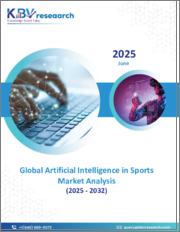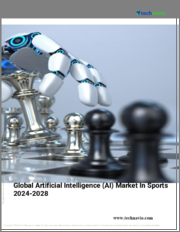
|
시장보고서
상품코드
1630755
세계의 스포츠 분야 인공지능(AI) 시장 규모, 점유율, 성장 분석 : 컴포넌트별, 용도별, 전개 형태별, 지역별 - 산업 예측(2025-2032년)Artificial Intelligence in Sports Market Size, Share, Growth Analysis, By Component (Service, Software), By Application (Player Analysis, Fan Engagement), By Deployment, By Region - Industry Forecast 2025-2032 |
||||||
스포츠 분야 인공지능 세계 시장 규모는 2023년 25억 5,000만 달러로 평가되었습니다. 2024년 33억 2,000만 달러에서 2032년에는 274억 2,000만 달러로 성장할 것으로 예상되며, 예측 기간(2025-2032년) 동안 30.2%의 연평균 복합 성장률(CAGR)을 나타낼 전망입니다.
스포츠 업계는 인공지능(AI)을 빠르게 도입하고 있으며, 경기 관리, 코칭, 이벤트 기획 등 다양한 분야에서 데이터 분석에 활용하고 있습니다. 최근 AI 기술의 발전은 선수와 주최자 모두에게 스포츠 경험을 향상시킬 수 있는 수많은 기회를 창출하고 있으며, 개인화된 상호작용을 통해 팬들의 참여를 크게 향상시키고 있습니다. 판타지 스포츠 리그의 인기가 높아지면서 이 분야의 AI 솔루션에 대한 수요가 더욱 증가하고 있습니다. 그러나 이 시장은 데이터 프라이버시에 대한 우려와 향후 성장을 저해할 수 있는 보급 장애물 등 잠재적인 과제에 직면해 있습니다. 스포츠에 AI의 통합이 계속 진화하는 가운데, 이해관계자들은 지속 가능한 발전을 보장하기 위해 혁신과 이러한 새로운 문제를 해결하는 것 사이에서 균형을 맞추어야 합니다.
목차
서론
- 조사 목적
- 조사 범위
- 정의
조사 방법
- 정보 조달
- 2차 데이터와 1차 데이터 방법
- 시장 규모 예측
- 시장 전제조건과 제한
주요 요약
- 세계 시장 전망
- 공급과 수요 동향 분석
- 부문별 기회 분석
시장 역학과 전망
- 시장 개요
- 시장 규모
- 시장 역학
- 성장 촉진요인과 기회
- 성장 억제요인과 과제
- Porter의 Five Forces 분석
주요 시장 인사이트
- 중요 성공 요인
- 경쟁 정도
- 주요 투자 기회
- 시장 생태계
- 시장의 매력 지수(2024년)
- PESTEL 분석
- 거시경제 지표
- 밸류체인 분석
- 가격 분석
- 사례 연구
- 기술 진보
- 규제 상황
- 스타트업 분석
- 특허 분석
스포츠 분야 인공지능(AI) 시장 규모 : 컴포넌트별 & CAGR(2025-2032년)
- 시장 개요
- 서비스
- 소프트웨어
스포츠 분야 인공지능(AI) 시장 규모 : 용도별 & CAGR(2025-2032년)
- 시장 개요
- 선수 분석
- 퍼포먼스 추적
- 부상 예방
- 스킬 개발
- 팬 참여
- 맞춤 컨텐츠
- 인터랙티브 체험
- 데이터 분석이및 분석
- 게임 전략
- 예측 분석
- 기타
- 스포츠 방송
- 티켓 판매 최적화
스포츠 분야 인공지능(AI) 시장 규모 : 전개 형태별 & CAGR(2025-2032년)
- 시장 개요
- 온프레미스
- 클라우드
스포츠 분야 인공지능(AI) 시장 규모 : 지역별 & CAGR(2025-2032년)
- 북미
- 미국
- 캐나다
- 유럽
- 독일
- 스페인
- 프랑스
- 영국
- 이탈리아
- 기타 유럽
- 아시아태평양
- 중국
- 인도
- 일본
- 한국
- 기타 아시아태평양
- 라틴아메리카
- 브라질
- 기타 라틴아메리카
- 중동 및 아프리카
- GCC 국가
- 남아프리카공화국
- 기타 중동 및 아프리카
경쟁 정보
- 주요 5개사 비교
- 주요 기업의 시장 포지셔닝(2024년)
- 주요 시장 기업이 채택한 전략
- 시장 최근 동향
- 기업의 시장 점유율 분석(2024년)
- 주요 기업 개요
- 기업 개요
- 제품 포트폴리오 분석
- 부문별 점유율 분석
- 매출 전년대비 비교(2022-2024)
주요 기업 개요
- IBM Corporation(USA)
- Microsoft Corporation(USA)
- Google LLC(Alphabet Inc.)(USA)
- Amazon Web Services, Inc.(USA)
- SAP SE(Germany)
- Oracle Corporation(USA)
- Salesforce.com, Inc.(USA)
- Adobe Inc.(USA)
- Intel Corporation(USA)
- Facebook, Inc.(Meta Platforms, Inc.)(USA)
- Apple Inc.(USA)
- Sony Corporation(Japan)
- NVIDIA Corporation(USA)
- Infosys Limited(India)
- Accenture plc(Ireland)
- Cognizant Technology Solutions Corporation(USA)
- Wipro Limited(India)
- Capgemini SE(France)
- HCL Technologies Limited(India)
- Tata Consultancy Services Limited(India)
결론과 추천 사항
LSH 25.03.04Global Artificial Intelligence in Sports Market size was valued at USD 2.55 billion in 2023 and is poised to grow from USD 3.32 billion in 2024 to USD 27.42 billion by 2032, growing at a CAGR of 30.2% during the forecast period (2025-2032).
The sports industry is rapidly embracing artificial intelligence (AI), utilizing it for data analysis across various applications, including game management, coaching, and event planning. Recent advancements in AI technology have created numerous opportunities for enhancing sports experiences for both athletes and organizers, significantly improving fan engagement through personalized interactions. The rising popularity of fantasy sports leagues further drives the demand for AI solutions in this sector. However, the market faces potential challenges, including data privacy concerns and hurdles in widespread adoption that could impede future growth. As the integration of AI in sports continues to evolve, stakeholders must balance innovation with addressing these emerging issues to ensure sustainable progress.
Top-down and bottom-up approaches were used to estimate and validate the size of the Global Artificial Intelligence In Sports market and to estimate the size of various other dependent submarkets. The research methodology used to estimate the market size includes the following details: The key players in the market were identified through secondary research, and their market shares in the respective regions were determined through primary and secondary research. This entire procedure includes the study of the annual and financial reports of the top market players and extensive interviews for key insights from industry leaders such as CEOs, VPs, directors, and marketing executives. All percentage shares split, and breakdowns were determined using secondary sources and verified through Primary sources. All possible parameters that affect the markets covered in this research study have been accounted for, viewed in extensive detail, verified through primary research, and analyzed to get the final quantitative and qualitative data.
Global Artificial Intelligence In Sports Market Segmental Analysis
Global Artificial Intelligence in Sports Market is segmented by Component, Application, Deployment and region. Based on Component, the market is segmented into Service and Software. Based on Application, the market is segmented into Player Analysis, Fan Engagement, Data Interpretation & Analysis and Other. Based on Deployment, the market is segmented into On-Premises and Cloud. Based on region, the market is segmented into North America, Europe, Asia Pacific, Latin America and Middle East & Africa.
Driver of the Global Artificial Intelligence In Sports Market
The Global Artificial Intelligence in Sports market is significantly driven by the advancement of performance analysis techniques. By leveraging artificial intelligence, sports organizations can obtain precise metrics for ongoing evaluation of athletes, delivering invaluable insights that aid in informed decision-making. AI excels at processing vast amounts of data swiftly, facilitating an accelerated approach to performance assessment. This capability not only enhances the accuracy of evaluations but also enables coaches and management teams to devise strategies tailored to individual athlete needs, ultimately leading to improved overall performance and competitive advantage in the sports industry.
Restraints in the Global Artificial Intelligence In Sports Market
The Global Artificial Intelligence in Sports market is facing significant constraints, primarily due to data privacy concerns. The implementation of AI technologies in sports necessitates the collection of sensitive information pertaining to athletes and teams, raising valid worries about the confidentiality and security of such data. These apprehensions surrounding data breaches and unauthorized access could impede the growth of the AI in sports sector in the future, as stakeholders may be hesitant to adopt AI solutions without robust privacy protections in place. Consequently, ensuring data security will be crucial for the sustained advancement of this market.
Market Trends of the Global Artificial Intelligence In Sports Market
The Global Artificial Intelligence in Sports market is witnessing a significant trend towards AI-driven broadcasting and content creation, as organizations strive to enhance operational efficiency and viewer engagement. By integrating AI technologies into live broadcasting, sports entities can automate camera systems for better angles and immersive experiences while leveraging advanced editing tools for real-time highlight generation. This innovative approach not only streamlines production processes but also personalizes content delivery, catering to the specific interests of fans. As competitiveness in the sports industry heightens, the demand for AI solutions that elevate broadcasting effectiveness and creativity is expected to grow, solidifying AI's role in shaping the future of sports media.
Table of Contents
Introduction
- Objectives of the Study
- Scope of the Report
- Definitions
Research Methodology
- Information Procurement
- Secondary & Primary Data Methods
- Market Size Estimation
- Market Assumptions & Limitations
Executive Summary
- Global Market Outlook
- Supply & Demand Trend Analysis
- Segmental Opportunity Analysis
Market Dynamics & Outlook
- Market Overview
- Market Size
- Market Dynamics
- Drivers & Opportunities
- Restraints & Challenges
- Porters Analysis
- Competitive rivalry
- Threat of substitute
- Bargaining power of buyers
- Threat of new entrants
- Bargaining power of suppliers
Key Market Insights
- Key Success Factors
- Degree of Competition
- Top Investment Pockets
- Market Ecosystem
- Market Attractiveness Index, 2024
- PESTEL Analysis
- Macro-Economic Indicators
- Value Chain Analysis
- Pricing Analysis
- Case Studies
- Technology Advancement
- Regulatory Landscape
- Startup Analysis
- Patent Analysis
Global Artificial Intelligence in Sports Market Size by Component & CAGR (2025-2032)
- Market Overview
- Service
- Software
Global Artificial Intelligence in Sports Market Size by Application & CAGR (2025-2032)
- Market Overview
- Player Analysis
- Performance Tracking
- Injury Prevention
- Skill Development
- Fan Engagement
- Personalized Content
- Interactive Experiences
- Data Interpretation & Analysis
- Game Strategy
- Predictive Analytics
- Other
- Sports Broadcasting
- Ticket Sales Optimization
Global Artificial Intelligence in Sports Market Size by Deployment & CAGR (2025-2032)
- Market Overview
- On-Premises
- Cloud
Global Artificial Intelligence in Sports Market Size & CAGR (2025-2032)
- North America (Component, Application, Deployment)
- US
- Canada
- Europe (Component, Application, Deployment)
- Germany
- Spain
- France
- UK
- Italy
- Rest of Europe
- Asia Pacific (Component, Application, Deployment)
- China
- India
- Japan
- South Korea
- Rest of Asia-Pacific
- Latin America (Component, Application, Deployment)
- Brazil
- Rest of Latin America
- Middle East & Africa (Component, Application, Deployment)
- GCC Countries
- South Africa
- Rest of Middle East & Africa
Competitive Intelligence
- Top 5 Player Comparison
- Market Positioning of Key Players, 2024
- Strategies Adopted by Key Market Players
- Recent Developments in the Market
- Company Market Share Analysis, 2024
- Company Profiles of All Key Players
- Company Details
- Product Portfolio Analysis
- Company's Segmental Share Analysis
- Revenue Y-O-Y Comparison (2022-2024)
Key Company Profiles
- IBM Corporation (USA)
- Company Overview
- Business Segment Overview
- Financial Updates
- Key Developments
- Microsoft Corporation (USA)
- Company Overview
- Business Segment Overview
- Financial Updates
- Key Developments
- Google LLC (Alphabet Inc.) (USA)
- Company Overview
- Business Segment Overview
- Financial Updates
- Key Developments
- Amazon Web Services, Inc. (USA)
- Company Overview
- Business Segment Overview
- Financial Updates
- Key Developments
- SAP SE (Germany)
- Company Overview
- Business Segment Overview
- Financial Updates
- Key Developments
- Oracle Corporation (USA)
- Company Overview
- Business Segment Overview
- Financial Updates
- Key Developments
- Salesforce.com, Inc. (USA)
- Company Overview
- Business Segment Overview
- Financial Updates
- Key Developments
- Adobe Inc. (USA)
- Company Overview
- Business Segment Overview
- Financial Updates
- Key Developments
- Intel Corporation (USA)
- Company Overview
- Business Segment Overview
- Financial Updates
- Key Developments
- Facebook, Inc. (Meta Platforms, Inc.) (USA)
- Company Overview
- Business Segment Overview
- Financial Updates
- Key Developments
- Apple Inc. (USA)
- Company Overview
- Business Segment Overview
- Financial Updates
- Key Developments
- Sony Corporation (Japan)
- Company Overview
- Business Segment Overview
- Financial Updates
- Key Developments
- NVIDIA Corporation (USA)
- Company Overview
- Business Segment Overview
- Financial Updates
- Key Developments
- Infosys Limited (India)
- Company Overview
- Business Segment Overview
- Financial Updates
- Key Developments
- Accenture plc (Ireland)
- Company Overview
- Business Segment Overview
- Financial Updates
- Key Developments
- Cognizant Technology Solutions Corporation (USA)
- Company Overview
- Business Segment Overview
- Financial Updates
- Key Developments
- Wipro Limited (India)
- Company Overview
- Business Segment Overview
- Financial Updates
- Key Developments
- Capgemini SE (France)
- Company Overview
- Business Segment Overview
- Financial Updates
- Key Developments
- HCL Technologies Limited (India)
- Company Overview
- Business Segment Overview
- Financial Updates
- Key Developments
- Tata Consultancy Services Limited (India)
- Company Overview
- Business Segment Overview
- Financial Updates
- Key Developments

















